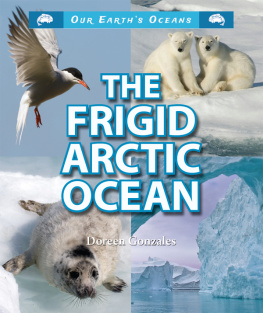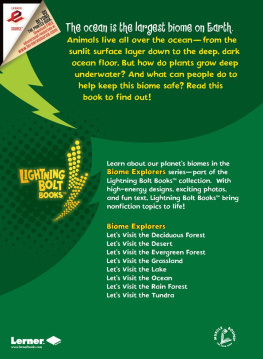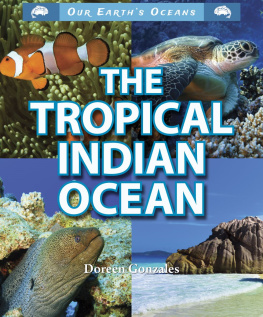Ocean
Food Webs
in Action
Paul Fleisher
Copyright 2014 by Lerner Publishing Group, Inc.
All rights reserved. International copyright secured. No part of this book may be
reproduced, stored in a retrieval system, or transmitted in any form or by any means
electronic, mechanical, photocopying, recording, or otherwisewithout the prior written
permission of Lerner Publishing Group, Inc., except for the inclusion of brief quotations in
an acknowledged review.
Lerner Publications Company
A division of Lerner Publishing Group, Inc.
241 First Avenue North
Minneapolis, MN 55401 USA
Website address: www.lernerbooks.com
Library of Congress Cataloging-in-Publication Data
Fleisher, Paul.
Ocean food webs in action / by Paul Fleisher.
p. cm. (Searchlight bookswhat is a food web?)
Includes index.
ISBN 9781467712552 (lib. bdg. : alk. paper)
ISBN 9781467717779 (eBook)
1. Marine ecologyJuvenile literature. 2. Marine plantsJuvenile literature.
3. Marine animalsJuvenile literature. I. Title.
QH541.5.S3F54 2014
577.7dc23 2012034177
Manufactured in the United States of America
2 BP 2/1/14
Contents
AN OCEAN FOOD WEB
Chapter
THE OCEAN
From space, our world looks
mostly blue. Look at a globe.
Most of the globe is
blue. Blue means
water. We call
our planet Earth.
Maybe we should
call it Ocean.
Almost three- fourths
of the world is covered
with ocean.
Most water on Earth is
ocean water. Ocean water
is salty. It is too salty to
drink. But it is full of life.
This is how Earth looks from
space. The green parts are
land. What are the blue areas?
A hawksbill
turtle eats
a jellyfish in
the ocean.
Creatures in the Ocean
Creatures of all sizes live in the ocean. Some are tiny.
They are too small to see. Some are very big. Whales
live in the ocean. They are the biggest animals on Earth.
Fish swim in the ocean. Worms burrow in the mud of
the ocean floor. Clams live in the mud too. Crabs crawl
along the bottom. Seabirds fly above the water. Many
creatures live along the shore.
The ocean is a very important environment. An
environment is the place where any creature lives. The
ocean environment includes air, water, sand or mud, and
weather, as well as plants and animals.
EARTHS OCEANS
There are five oceans on Earth.
Food and Energy
Living things in the ocean environment depend on one
another. They form a web of life. Some animals eat
plants. Other animals are meat eaters. Some creatures
feed on dead plants and animals. When plants and
animals die, they break down into chemicals. The
chemicals help other plants grow.
Fin whales and seabirds
feed on fish called herring.
The herring feed on tiny
ocean plants and animals.
Turban snails get
energy from food
they scrape off kelp.
Living things get energy from food. Energy moves
from one living thing to another. A food chain shows
how the energy moves. The energy for life comes from
the sun. The suns energy is stored in plants. Animals
eat the plants. They get some of the suns energy from
the plants. The energy moves along the food chain.
When one creature eats another, some of the energy is
passed on.
Food Chains
There are many
food chains in the
ocean. Here is one
example. A snail
eats plants. Then a
fish eats the snail.
Then a seal eats the
fish. When the seal
dies, crabs eat its
body. Some of the
suns energy goes
from the plants
to the snail. Then
energy is passed
to the fish. Then
energy goes to the
seal. Crabs get
energy from the
dead seal.
THIS HARBOR SEAL
CAUGHT A FISH.
A food web is made of many food chains. Fish eat
other things besides snails. They eat clams. They also
eat worms and other fish. Seals eat many different kinds
of fish. They eat octopuses and squid too. Crabs feed
on all kinds of dead animals and plants. Everything each
creature eats is part of a food web. A food web shows
how all living things in an environment depend on one
another for food.
This gull has
found a dead
fish to eat.
Chapter
OCEAN
PLANTS
Green plants
use sunlight
to make food.
Living things
that make their
own food are
called producers.
Animals use the
food plants produce.
Plants also make
oxygen. Oxygen is
a gas in the air and
water. Animals need
oxygen to breathe.
Sunlight shines through a giant
kelp forest. Kelp and other ocean
plants use sunlight to make food.
What else do they make?
Making Food and Oxygen
Plants make food and oxygen through photosynthesis.
Plants need sunlight for photosynthesis. They also need
carbon dioxide and water. Carbon dioxide is a gas in the
air. It is in the water too. Plants take in carbon dioxide.
They take in water. Plants use energy from sunlight to
turn water and carbon dioxide into sugar and starch.
Sugar and starch are the plants food. Plants store the
food in their bodies.
HOW PHOTOSYNTHESIS WORKS
Bull kelp use sunlight, carbon dioxide, and
water to make their own food.
Plants also make oxygen as they make food. The
oxygen goes into the air and water. Animals breathe the
oxygen. They breathe out carbon dioxide. Plants use the



























